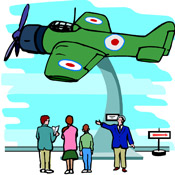|
©
Copyright 2004 by Cindy Downes. All rights reserved.
BEFORE
THE TRIP:
 Step
1. Select a destination and
write down the details. Include the date and time of the
trip, the address and directions for the destination, and
the contact’s name and phone
number. Step
1. Select a destination and
write down the details. Include the date and time of the
trip, the address and directions for the destination, and
the contact’s name and phone
number.
Step
2. Set learning objectives. Is this trip going to
be educational or a fun, social outing? Don’t make every
field trip an educational project or your kids will hate them!
Take some trips just for the fun of it. They will still learn
something. If the field trip is educational, I recommend that
you limit your group to your own family or include one or
two other families who have children with whom your children
work well. Save big group trips for “fun” outings. Set
learning objectives by asking yourself, what is the purpose
for the trip and how does it relate to our current topic
of study? For example, if you are studying geology, schedule
a field trip to collect rocks. Your learning objectives will
be to learn about different types of rocks, how to identify
them, and how mankind uses them in everyday life. By setting
these objectives, it is easier to plan activities that will
reinforce your child’s learning.
Step
3. Make a list of what to wear and bring. Make sure
your children are appropriately dressed by planning ahead.
Make a list of items to bring such as food, money, informational
materials, activity supplies, and a first-aid kit.
Step
4. Prepare activities to help your children get the
most from the trip.
- Assign
reading materials to help them understand what they are
going to learn. For example, on the geology trip, have them
read a book about rock formation or rock collecting.
- Teach
them any new vocabulary they will need and have them create
a dictionary of terms to keep in their notebook.
- Integrate
activities into your normal school day. For example, have
them write a business letter to a local chamber of commerce
requesting information about the destination. Use this as
a composition assignment for the day.
- Create
a scavenger hunt for the trip. Make a list of items to find
while on their trip. For example, paintings by a certain
artist, animals in a zoo, items used on a farm, etc. The
one who finds the most (or a certain number of) items gets
a prize.
DURING
THE TRIP:
Step
5: Set a good example for your kids by being on time
and obeying the rules of your field trip coordinator . Homeschool
parents tend to be very independent and have a tendency of
not following the rules. Remember, your children will do what
you do, not what you say!
Step
6: Have your children complete assigned activities.
For example: make drawings, take photos or videos, make recordings
of what they hear, or take notes for a future composition
project.
AFTER
THE TRIP:
Step
7: Assign reading to reinforce what they learned.
 Step
8: Do activities to reinforce what they learned.
Have them create a crossword puzzle with the vocabulary words
they learned, use their photos, videos, and sound recordings
in a multimedia project, or create a memory book page from
brochures and photos. Step
8: Do activities to reinforce what they learned.
Have them create a crossword puzzle with the vocabulary words
they learned, use their photos, videos, and sound recordings
in a multimedia project, or create a memory book page from
brochures and photos.
Step
9: Finally, have them write a thank you note to
the trip coordinator or tour guide. Teach your children to
be grateful for other’s time.
By
following the above nine steps, your children will not
only have fun, but they will learn academic skills as well
as social skills. Now, that’s a successful field
trip!
Print
out the free Field
Trip Planning Guide (Acrobat Reader document) to
help you prepare your next field trip.
Visiting
Oklahoma? Be sure to check out Oklahoma
Scrapbook by
Cindy Downes
Keep
track of your travel learning with The Checklist
. |